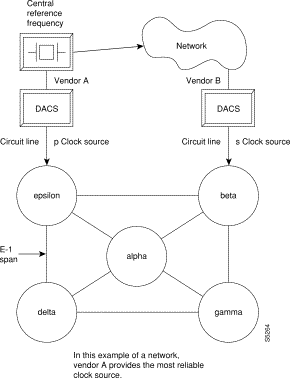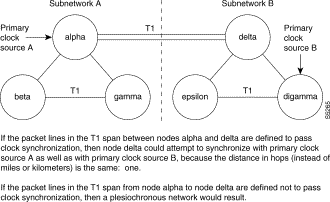|
|

This chapter describes how to synchronize a network and the commands related to synchronization.
Available clock sources are defined within the network as primary (p), secondary (s), or tertiary (t). This hierarchy is based on clock source stability. Each trunk that can pass clock synchronization is defined. Each network node's clock is based on the most stable clock source. If multiple, equal clock sources are available, each node chooses the closest one (measured in number of hops).
Clock sources may be changed manually by the user, or automatically by the IPX/BPX. If there are no primary, secondary, or tertiary clock sources defined or working in a network, then the internal oscillator of one node is automatically selected as the active network clock source.
Whenever a clock source changes—because of a line repair or an operator's command, for example—the node ensures that the clock path remains hierarchical. Also, whenever a subnetwork is merged with another subnetwork, each node in the new network verifies that it has the nearest, most stable clock that is available.
A continuous clock test compares the frequency of the node clock source to a reference on the control card. If it detects a clock source outside preset frequency limits, the controller declares the source defective and selects another source.
Typically, network clock sources and line characteristics are configured as part of the node installation process. After installation, you can redefine clock sources when you reconfigure a network or change the status of a line status.
Clock sources are user-defined as primary, secondary, or tertiary. The definition depends on the stability of the clock source. Considerations for assessing and defining clock sources include:
A plesiochronous network is a network in which there are two or more independent, active clock sources. For example, a network in which multiple vendors provide multiple lines that require clock mastership can be a plesiochronous network. The following depicts clock source reliability.


One trunk parameter is the ability to pass a clock. A line passes a clock if the clock information transmitted from one end arrives as the identical clock at the other end. Normal T1 or E1 lines pass clock. Lines that do not normally pass clock include:
A long-distance line that passes through another provider's network may or may not pass clock. The default ability for an IPX or IGX trunk is to pass clock. The following applies to clocks and lines:
Network synchronization includes specification of primary, secondary, and tertiary clock sources. The latter two sources serve as backups in case of clock failures. The cnfclksrc command specifies the source of a clock and can remove a previously specified clock source. Multiple primary sources, multiple secondary sources, and multiple tertiary sources are allowed.
The designation of the clock source depends on the stratum (or stability) of the clock source. Each node in the network synchronizes to the nearest (fewest number of hops) primary clock source. If no primary source is available, the nearest secondary clock source is used, and so on. If no other source is available, the network synchronizes to the internal oscillator of one of the nodes in the network. The following commands manage the network clocks.
· cnfclksrc | which can either specify or remove a primary, secondary, or tertiary clock source in a network. |
· dspclksrcs | which displays all the currently defined clock sources. |
· dspcurclk | displays the current clock source being used by the network. |
· clrclkalm | Clears an alarm associated with a clock source. The cause of an alarm usually is a current clock source that fails or is outside of frequency limits. You must clear a clock source alarm before that clock source is usable. |
Table 12-1 shows the full name and starting page for the description of each command.
| Command | Description | Page |
|---|---|---|
clrclkalm | Clear clock alarm | |
cnfclksrc | Configure clock source | |
dspclksrcs | Display clock sources | |
dspcurclk | Display current clock |
Clears the alarm status of a clock source after a problem is cleared. (The alarm can be a "Bad Clock Source" or "Bad Clock Path.") Before the node can use the original clock source, you must clear the alarm with clrclkalm. The system displays no messages after execution.
Clear clock alarm
clrclkalm <line type> <line number>
cnfclksrc, dspclksrcs, dspclns, dspcurclk, dsptrks
Privilege | 1-5 |
Jobs | No |
Log | Yes |
Node | IPX, IGX, BPX |
Lock | Yes |
clrclkalm c 12
Description
Clear a clock alarm on circuit line 12
clrclkalm p 12
Description
Clear clock alarm on trunk 12
| Parameter | Description |
|---|---|
c/p | Specifies the type of line. A "c" indicates a circuit line. A "p" indicates a trunk. |
line number | Specifies the number of the circuit line or trunk. |
Specifies a network-wide clock source. The clocking scheme ensures that all nodes in the network automatically synchronize to the nearest, most stable clock available. After you specify a clock source, the location and type of the network clock source goes out to all nodes in the network. This synchronization remains in effect despite line failures, power outages, controller card switchovers, line repairs, and the joining of subnetworks and all other network topology changes. Each node in the network maintains a list of the available clock sources for the network.
A clock source can be either circuit line (C), a trunk (P), or an external source (E). The clock type can be primary (P), secondary (S), or tertiary (T). To remove a clock source, enter its type as "r" at the end of the cnfclksrc command line.
Designation of the clock type depends on the stratum (or stability) of the clock source. In a large network, for example, you could designate all stratum 2 clocks as "primary," all stratum 3 clocks as "secondary," and all stratum 4 clocks as "tertiary." The network regards all primary clocks as equal in the network clocking hierarchy, regards all secondary clocks as equal, and regards all tertiary clocks as equal. Each node synchronizes to the highest stratum clock source that is available. If multiple, equal clock sources are available, the node synchronizes to the source that is physically the closest. If none of the sources is available, the network synchronizes to the internal oscillator of one of the nodes in the network. When you are planning clock sources, consider the following:
Configure network clock source
cnfclksrc <line type> <line number> <source type> [freq]
dspclksrcs, dspcurclk
Privilege | 1 |
Jobs | No |
Log | Yes |
Node | IPX, IGX, BPX |
Lock | Yes |
cnfclksrc c 15 p
Description
Configure circuit line 15 as a primary clock. The network clock sources screen shows that circuit line 15 has been configured as a primary clock source for the network.
bootzilla TRM YourID:1 IPX 32 8.4 Mar. 15 1996 15:31 MST
Network Clock Sources
Primary
bootzilla CLN 15
Secondary
None
Tertiary
None
Last Command: cnfclksrc c 15 p
Next Command:
| Parameter | Description |
|---|---|
line type | Specifies whether the clock source is a trunk (p), circuit line (c), or external (e). |
line number | For a network clock source of either a circuit (c) or trunk (p), this specifies the back slot location of the source. For external clock sources (e), enter either front card slot 1 or 2 as long as either slot has a card. This external source designation applies to IPX, IGX, and BPX nodes. |
source type | Specifies where the clock fits in the hierarchy: p = primary; s = secondary; and t = tertiary. To remove the clock source configuration for the current type and line, enter an "r." |
| Parameter | Description |
|---|---|
freq | Specifies the frequency of the clock source. An entry is necessary only if the line type is an external line. The supported frequencies are 1.544 MHz and 2.048 MHz. Enter a "1" for 1.544 MHz or a "2" for 2.048 MHz. |
Displays all clock sources for the network. The display for unreachable or failed clock sources flashes on and off.
Display network clock sources
dspclksrcs
cnfclksrc, dspcurclk
Privilege | 1-6 |
Jobs | No |
Log | No |
Node | IPX, IGX, BPX |
Lock | No |
dspclksrcs
Description
Display the network clock sources
bootzilla TRM YourID: Numba 1 IPX 32 8.4 Mar. 15 1996 15:32 MST
Network Clock Sources
Primary
bootzilla CLN 15
Secondary
None
Tertiary
None
Last Command: dspclksrcs
Next Command:
Displays the current clock source. The display for dspcurclk contains the following information:
Display current clock sources
dspcurclk
cnfclksrc, dspclksrcs
Privilege | 1-6 |
Jobs | No |
Log | No |
Node | IPX, IGX, BPX |
Lock | No |
dspcurclk
Description
Display the current clock source
bootzilla TRM YourID:1 IPX 32 8.4 Mar. 15 1996 15:33 MST
Current Clock Source
Source Node: gamma
Source Line: Internal
Clock Type:
Clock Frequency: 1544015
Path to Source:
bootzilla 9--10gamma
Last Command: dspcurclk
Next Command:
![]()
![]()
![]()
![]()
![]()
![]()
![]()
![]()
Posted: Thu Jan 18 13:05:42 PST 2001
All contents are Copyright © 1992--2001 Cisco Systems, Inc. All rights reserved.
Important Notices and Privacy Statement.